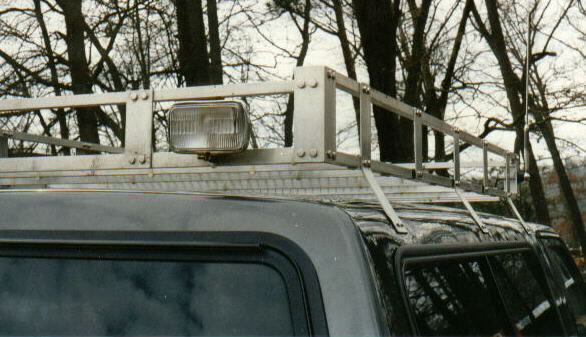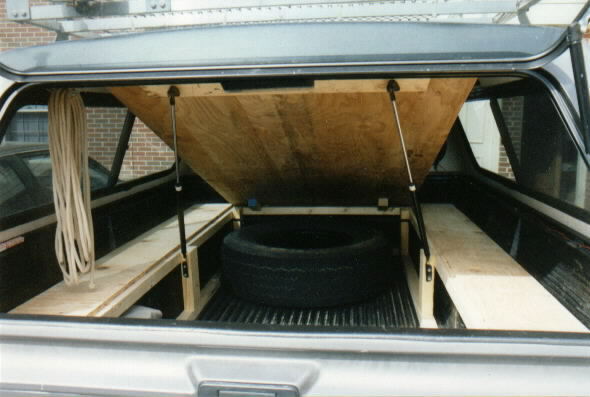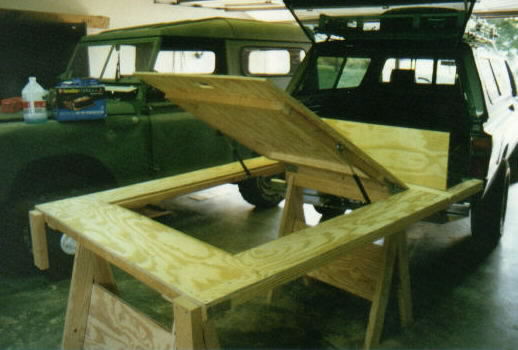
I bought this 1987 Toyota 2WD pick-up during the summer
of 1994 with 80k miles on it. It took me from Central
America to the Arctic Circle and never
let me down. It had over 165k miles on the odometer when I gave it
away in June, 2002.
Modifications:
This vehicle began it's life as a 1/2-ton 2WD short bed pickup. Long before I owned it, someone decided they needed more ground clearance and bigger tires. They lifted the body 3 inches, added new Downey torsion bars to the front suspension, got some 15" aluminum wheels and 295/75-R15 tires.
These modifications resulted in a vehicle that looks and feels much like a 4WD truck, but handles much better and gets better gas mileage. It sits about an inch lower than a stock Toyota 4WD pickup with similar tires (hence a lower center of gravity) and has a stiff sway bar in the front. Ground clearance is very good but off road performance is not impressive. This truck has literally gotten stuck in wet grass (among other places).
The benefits of this layout over a stock 2WD truck are obvious. Increased clearance around the wheel arches for larger tires helps off road. A higher stance means a more commanding view of the road, as well as a better vantage point for sightseeing. It has a cost (both initial and long term) and simplicity advantage over a 4WD vehicle. The drive train is simpler and tire wear and gas consumption are reduced. If 4WD traction is not truly necessary then I believe this is the way to travel.
Toyota has finally realized the benefits also. As of 1998, they offer a 2WD truck with the look and stance of a 4WD: the "PreRunner". I now own a 2001 4-door and love it.
The truck also had that huge welded 4" tube bumper (the
"lips") on the front when I bought it. I don't know who made
that thing or what they were thinking, but it is far stronger than the
vehicle's frame to which it is bolted.
Additions:
Besides the obvious body lift and larger tires, other changes have been
made to this vehicle to make it better suited to long
distance travel.
Cap: Early on I added a Leer
bed cap painted to match the body and have been very happy with it.
It came with a cheesy battery powered interior light but I quickly converted
that to run off of the vehicle's 12V system. The cap is very solid
and has put up with a tremendous amount of abuse. I highly recommend
them.
Rack: Adding a cap to the bed caused problems
when carrying long objects (lumber, ladders, sailboat spars, etc.) so I
built
a rack for the truck. At the time I didn't know where I might be
taking it but decided to make an expedition-style
rack instead of a frumpy ladder rack. My college roommate and
I drilled and sawed aluminum stock in our kitchen for weeks until we had
what you see here. It is about 3-1/2 feet wide and almost 6 feet
long. The sides were made slightly higher than the front and rear
so that long objects wouldn't slide off of the side while driving.
Expanded metal forms the rather inadequate surface. 1/8" plates were
bent to mate with the side of the fiberglass cap and holes were drilled.
Twelve stainless steel bolts hold the rack tightly to the cap and small
aluminum plates inside the cap spread the load and reduce stress concentration.
Lights: The rack is also a nice mounting point
for some rear facing work lights which have seen a lot of use. They
are controlled by a lighted switch on the dashboard. On the front
of the truck I installed a prerunner-style brush guard which holds two
round Hella 250W lights. The brush
guard is light duty but serves to rigidly mount the lights and also hold
expanded metal that protects the headlights and radiator. My experience
has been that roof rack mounted lights offer no advantage over front mounted
lights and sometimes cause additional glare, not to mention they get snagged
by tree branches. When switched 'on', the Hellas come on only with
the vehicle's bright lights.
 Brush guard with expanded metal light protection
Brush guard with expanded metal light protection
 Navigation:
The Belize trip was done on a shoe-string
budget since I was a student at the time. We used a marine type compass
stuck on the windshield to aid navigation. Being surrounded by steel,
this compass was wildly inaccurate and led us astray more than a few times.
Hence we upgraded to GPS navigation
for the Alaska trip. I was very pleased with the Eagle
Explorer 12 channel hand held unit (though it is now very out-of-date.)
I mounted an aluminum bracket on the dashboard and fixed the unit to it
with industrial Velcro. That setup proved very convenient when it
came time to hike around away from the vehicle. The GPS is powered
by the vehicle's 12V system unless removed, at which point the internal
batteries take over. Needless to say, a GPS system is worth its weight
in gold on a trip such as this.
Navigation:
The Belize trip was done on a shoe-string
budget since I was a student at the time. We used a marine type compass
stuck on the windshield to aid navigation. Being surrounded by steel,
this compass was wildly inaccurate and led us astray more than a few times.
Hence we upgraded to GPS navigation
for the Alaska trip. I was very pleased with the Eagle
Explorer 12 channel hand held unit (though it is now very out-of-date.)
I mounted an aluminum bracket on the dashboard and fixed the unit to it
with industrial Velcro. That setup proved very convenient when it
came time to hike around away from the vehicle. The GPS is powered
by the vehicle's 12V system unless removed, at which point the internal
batteries take over. Needless to say, a GPS system is worth its weight
in gold on a trip such as this.
Lately I have been using Garmin's eMap GPS with built-in basemap. It is ideal for vehicle travel since it has a large screen and all major highways in North and South America already mapped. Great product at a fair price.
The Eagle Explorer hand-held GPS receiver
Storage: Two adults living in a small truck
for two weeks is a joke. Time spent to make it more comfortable or
convenient is well invested. I added additional storage pockets to
the cab doors which were capable of holding quite a few maps and guidebooks.
We stored items everywhere imaginable- under the hood, on top of the spare
tire underneath the truck, under the carpet. Our most significant
storage strategy was also our sleeping system. I designed
and built a plywood platform level with the top of the wheel arches in
the truck bed. This allowed us to sleep in the back of the truck
and enjoy the full 52-inch bed width instead of being pinched between the
wheel arches. Our cooking equipment, food, and clothing was stored
under this platform. The surface of our "bed" was hinged at the front,
and could be lifted for access to the items beneath. The system worked
beautifully. Gas-filled struts were employed to help lift the bed
surface and support the weight of clothing and bedding which was usually
resting on the platform.

 Belize
trip "bed" shown open and closed
Belize
trip "bed" shown open and closed
Some improvements became apparent to me after the Belize trip. I realized that the structure I built out of 2x2's to support the plywood wasn't necessary and was only taking up valuable space. We also wanted access to some storage space through the rear window of the cab. Hence when I rebuilt the platform for the Alaska trip, I made some changes. At first I experimented with a complicated 4-bar design, but opted to forego that for the sake of simplicity. The final design is much like the Belize trip version but simpler and with two doors instead of just one.
 Alaska
trip "bed" on sawhorses- ready to be installed. Land
Rover visible in background.
Alaska
trip "bed" on sawhorses- ready to be installed. Land
Rover visible in background.
This version of the "bed" features a smaller front-facing door for access to food and overclothes from the cab. Note there is no support other than two short legs at the rear of the platform. The wheel arches take most of the weight of the occupants and the whole unit is held tightly in place when the tailgate is closed. The structure is glued and screwed for strength.
Contact me at [email protected]